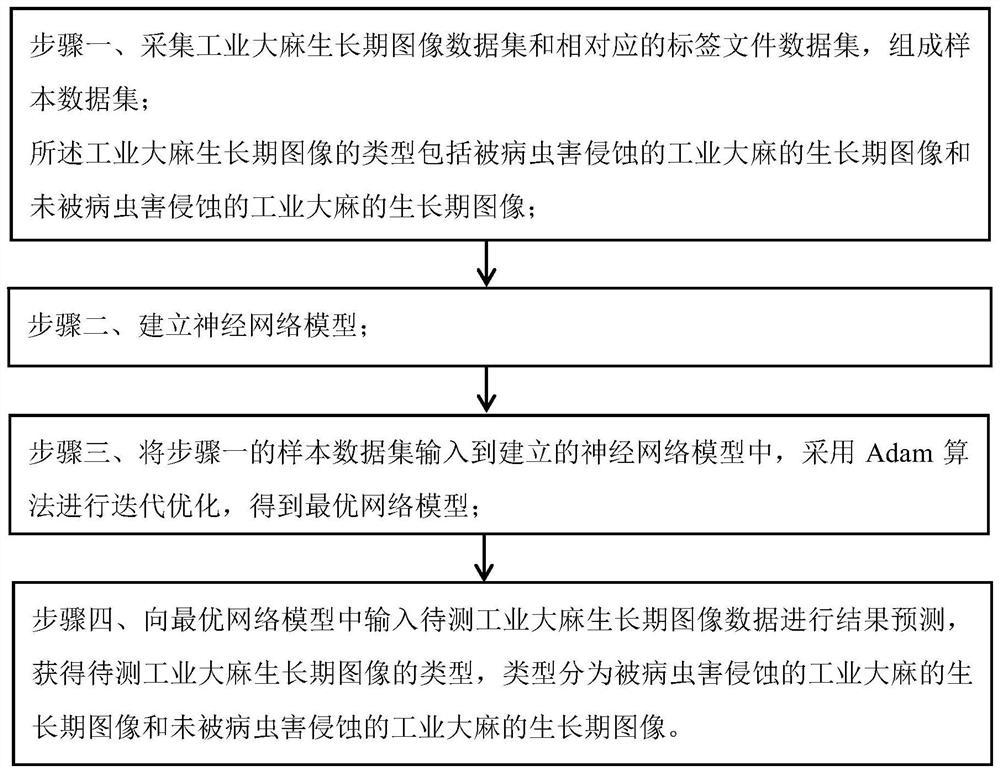Method and system for monitoring plant diseases and insect pests in growth period of industrial cannabis sativa
A technology for industrial hemp, diseases and insect pests, applied in neural learning methods, biological neural network models, image enhancement, etc., can solve the problems of lack of uniform standards, low work efficiency, plant erosion, etc., to suppress useless features and reduce network parameters Small, robust effects
- Summary
- Abstract
- Description
- Claims
- Application Information
AI Technical Summary
Problems solved by technology
Method used
Image
Examples
specific Embodiment approach 1
[0024] Specific implementation mode one: the specific process of a monitoring method for plant diseases and insect pests during the growth period of industrial hemp in this implementation mode is as follows:
[0025] Step 1, collect the industrial hemp growth period image data set and the corresponding label file data set to form a sample data set;
[0026] The types of the growth period images of industrial hemp include the growth period images of industrial hemp eroded by diseases and insect pests and the growth period images of industrial hemp not eroded by diseases and insect pests;
[0027] Step 2, establishing a neural network model;
[0028] Step 3. Input the sample data set in step 1 into the established neural network model, and use the Adam algorithm for iterative optimization to obtain the optimal network model;
[0029] Step 4. Input the image data of the growth period of the industrial hemp to be tested into the optimal network model for result prediction, and ob...
specific Embodiment approach 2
[0030] Specific embodiment 2: The difference between this embodiment and specific embodiment 1 is that in the step 1, the image data set of the growth period of industrial hemp and the corresponding label file data set are collected to form a sample data set; the specific process is:
[0031] Given a hyperspectral image Z={X,Y}, where X is the set of all pixel data of the image, and Y is the set of labels corresponding to all pixels; the hyperspectral image Z={X,Y} is input into the first input layer, The input image is processed pixel by pixel and filled to get N size S∈R H×W×L the cube;
[0032] Among them, H×W is the space size of the cube, and L is the number of spectral bands.
[0033] Other steps and parameters are the same as those in Embodiment 1.
specific Embodiment approach 3
[0034] Specific embodiment three: the difference between this embodiment and specific embodiment one or two is that the neural network model is established; the specific process is:
[0035] The neural network model includes: input layer, first three-dimensional convolution layer, first batch of normalization layer BN layer, first ReLU activation layer, spatial attention block, spectral attention block, second batch of normalization layer BN layer , the second ReLU activation layer, the first Dropout, the first global maximum pooling layer, the FC fully connected layer, the Softmax function classifier and the output layer;
[0036] The connection relationship of the neural network model is:
[0037] The input layer is connected to the first three-dimensional convolutional layer, the first three-dimensional convolutional layer is connected to the first batch of normalization layer BN layer, the first batch of normalization layer BN layer is connected to the first ReLU activatio...
PUM
 Login to View More
Login to View More Abstract
Description
Claims
Application Information
 Login to View More
Login to View More - R&D
- Intellectual Property
- Life Sciences
- Materials
- Tech Scout
- Unparalleled Data Quality
- Higher Quality Content
- 60% Fewer Hallucinations
Browse by: Latest US Patents, China's latest patents, Technical Efficacy Thesaurus, Application Domain, Technology Topic, Popular Technical Reports.
© 2025 PatSnap. All rights reserved.Legal|Privacy policy|Modern Slavery Act Transparency Statement|Sitemap|About US| Contact US: help@patsnap.com



